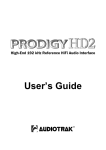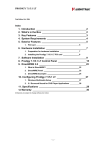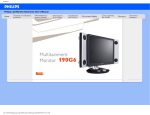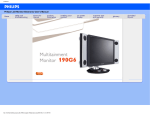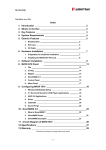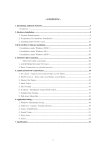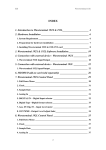Download ESI AUDIOTRAK Prodigy 7.1 HiFi User`s guide
Transcript
192 kHz 7.1 HiFi Surround Audio Interface User’s Guide AUDIOTRAK - Copyright © 2006 - 2007 Revision 2, August 2007 www.audiotrak.net AUDIOTRAK Prodigy 7.1 HiFi INDEX 1. Introduction.................................................................................................................................. 4 2. What’s in the box ......................................................................................................................... 4 3. Key Features................................................................................................................................. 4 4. System Requirements .................................................................................................................. 5 5. Connectors .................................................................................................................................... 5 6. Hardware Installation ................................................................................................................. 6 7. Software Installation.................................................................................................................... 8 8. Prodigy 7.1 HiFi Control Panel ................................................................................................ 10 9. DirectWIRE 3.0.......................................................................................................................... 15 10. Application Setup..................................................................................................................... 18 11. General Information ................................................................................................................ 19 3 AUDIOTRAK Prodigy 7.1 HiFi 1. Introduction Thank you for choosing the AUDIOTRAK Prodigy 7.1 HiFi. Prodigy 7.1 HiFi is an extremely powerful PCI multimedia digital audio interface ideal for Home Theater PCs, designed to satisfy both beginners and professionals looking for high quality digital audio solutions. Its unique design makes Prodigy 7.1 HiFi different from many other consumer sound cards, providing excellent audio quality, perfect for music and multimedia enthusiasts, game players and even for hobby musicians for home recording on a (semi-)professional level. 2. What’s in the box Your Prodigy 7.1 HiFi package contains the following: - Prodigy 7.1 HiFi PCI card - 15pin D-SUB breakout cable with 1/8" connectors - this manual - Windows driver software CD 3. Key Features Prodigy 7.1 HiFi is based on the powerful VIA Envy24HT (ICE1724) audio controller and the Wolfson WM8776 / 8766 audio codecs, providing 2, 4, 6 (5.1) and 8 (7.1) channel support as well as optical digital I/O with 24bit/196kHz support. To provide stable high level output signals, Prodigy 7.1 HiFi uses a fine selection of high quality capacitors from Sanyo (SP series) and from Nichicon (up to 2200uF RU series / Nichicon ES series) to optimize the power supply of the analog and digital components on the card and to optimize the audio output quality. The special design of Prodigy 7.1 HiFi with its 4 layer PCB cuts off electromagnetic waves from the internals of the PC – there won’t be problems with an unstable power supply caused by the systems CPU or the HDD. A separation between the analog and the digital part using an aluminium cover that shields the sound against electromagnetic waves is a major part of the Prodigy 7.1 HiFi design. Even better, the OpAmps on the card are installed on sockets, providing the possibility to change them to the users preference. The Prodigy 7.1 HiFi driver software is based on the EWDM standard from pro audio manufacturer ESI providing perfect compatibility with Windows 2000 / XP / 2003 / Vista, offering high performance and low latency operation with all important famous audio applications. The DirectWIRE 3.0 and Advanced NSP (Native Sound Processing) support in the driver allows you to virtually patch all your digital audio sources internally between various different software applications running at the same time and use effect plugins simultaneously. Audio streams can be transferred between different audio applications, which is especially great when using software effects, synthesizers or virtual instruments. The driver also includes support for the 3D technologies from QSound Labs in Canada: Q3D/QEM, QMSS, QRumble, QSizzle, QExpaner, QEQ and QNormalize. 4 AUDIOTRAK Prodigy 7.1 HiFi 4. System Requirements Prodigy 7.1 HiFi is a high end multimedia digital audio interface with many different functions and not just a simple sound card. Even though Prodigy 7.1 HiFi does not depend very much on the available CPU in your system, it is important that the computer meets the minimum system requirements. A faster CPU, faster HDD and more memory is generally recommended. Minimum System Requirements - at least Intel Pentium III or equivalent AMD CPU - motherboard with Intel or VIA chipset, or 100% compatible - at least 256MB of RAM - one available PCI slot - Microsoft Windows 2000, Windows XP, Windows 2003 or Windows Vista operating system - Ultra DMA66/100 and 5400rpm hard disk drive - active speakers or speakers with powered amplifier 5. Connectors 1) Stereo Line Output (left / right), provides the main output signal via RCA connectors 2) Microphone Input (mono 1/8", pink), for dynamic and electret microphones 3) Analog Output 7/8 (stereo 1/8", yellow), provides typically the Backgr. Surround signal 4) Analog Output 5/6 (stereo 1/8", black), provides typically the Center/Woofer signal 5) Analog Output 3/4 (stereo 1/8", orange), provides typically the Rear left/right signal 6) Analog Output 1/2 (stereo 1/8", green), provides the main Front left/right signal 7) Line In, analog input connector (stereo 1/8", blue), the main input 8) S/PDIF Digital In and Output, via Toslink connectors 5 AUDIOTRAK Prodigy 7.1 HiFi 6. Hardware Installation Prodigy 7.1 HiFi and other components in the computer could easily be damaged by electrical shocks. You should use an anti-static device that can discharge the static electricity of your body to avoid potential static damage to the cards. The Prodigy 7.1 HiFi card is shipped in an anti-static plastic pouch to protect it from static electricity - do not open the pouch before you install the card. 1. Turn off the computer power and remove the power cable from your computer power supply. Figure 1. Disconnecting the Power Cord 2. Refer to your computer user’s manual and remove the computer cover. Make sure that you have an available PCI slot on your motherboard to install the Prodigy 7.1 HiFi. Figure 2. Removing the computer cover To avoid possible static shock damage to the computer parts, discharge it by touching the computer case or something grounded. We recommend you use an anti-static device such as an anti-static wristband. When holding the Prodigy 7.1 HiFi card, touch only the guide or the edge of card. Do not grab the card by the board or connector. 3. Find an empty PCI slot on the motherboard 6 AUDIOTRAK Prodigy 7.1 HiFi Figure 3. Typical PC Motherboard Slot Configuration Figure 4. Removing the PCI Slot faceplate If the PCI slot is covered by a faceplate, you can remove it by removing the screw holding it in place or by prying it off with a screwdriver. Insert the Prodigy 7.1 HiFi card into the PCI slot, firmly pushing the card into the slot until it is seated securely. Replace the screw, and tighten it. Figure 5. Prodigy 7.1 HiFi installed in a PCI slot 4. Close the computer case. 7 AUDIOTRAK Prodigy 7.1 HiFi 5. Now it’s time to connect the D-SUB breakout cable to the 15pin D-SUB connector. Make sure it is connected properly. 7. Software Installation After completing the hardware installation, you need to install the Windows driver. The installation steps in the different versions of Windows vary, but they are typically very similar. This text refers to Windows XP. Note: Depending on your system, you may need the Windows installation CD. Note: Please make sure that you have installed a recent version of the chipset drivers and patches provided by your mainboard manufacturer for your mainboard. It is important that this is done before you install the Prodigy 7.1 HiFi drivers. One way to check this is to see if there are any unknown devices listed in Device Manager before you install the Prodigy 7.1 HiFi hardware. 1. Turn on your computer. Windows will automatically detect a new device and prompt you with Found New Hardware Wizard screen. Choose Cancel. Prodigy 7.1 HiFi comes with an automated installation program that does not require the Hardware Wizard from Windows. 2. After that, open the Windows Explorer or go to Start > Run and Browse to find the driver’s installer location. For example, it is under E:\AUDIOTRAK\PRODIGY71HIFI, if E: is your CDROM drive. There you will find a program called Setup_Prodigy71HiFi_vX_XX_XP2KME98.exe (where X_XX is the driver version number) that you need to launch. Follow the instructions on screen. 3. During installation in Windows 2000 and Windows XP, you will be prompted with a message warning once or several times that the driver software has not passed Windows Logo testing. Select Continue Anyway and proceed with the installation. The driver is completely tested and verified by AUDIOTRAK and safe to use. 8 AUDIOTRAK Prodigy 7.1 HiFi 4. After you complete the driver installation (by following all the instructions on screen), you should restart your computer. 5. After restarting Windows, you will see the Prodigy 7.1 HiFi control panel icon in your system tray (lower right corner of your desktop). Click on the icon to open the Prodigy 7.1 HiFi control panel. 6. Go to Device Manager, check the devices under ‘Sound, video and game controllers’. You will see the Prodigy 7.1 HiFi, Prodigy 7.1 HiFi Controller and QVE 96-24 (WDM) devices if you have completed the installation process correctly. Your Prodigy 7.1 HiFi is ready to use. 7. Go to Control Panel → Sounds and Audio Device Properties → Audio. 9 AUDIOTRAK Prodigy 7.1 HiFi You can choose each stereo device or multi channel device for your use as Default device on Sound playback or Sound recording which will be used as default in your audio applications. 8. Prodigy 7.1 HiFi Control Panel The Prodigy 7.1 HiFi driver software provides a simple yet powerful interface with your computer. The Prodigy 7.1 HiFi driver provides two operation modes. The normal Prodigy 7.1 HiFi operation is used for digital recording and normal audio output. The other mode QVE96-24 is based on the 3D sound effect QSound Engine for multi surround sound or gaming. The control panel gives you control over both driver functions. The following table compares the two different operation modes: The Prodigy 7.1 HiFi control panel is installed in your system when you complete the driver installation. To open the panel, double click the red AUDIOTRAK icon in the system tray. While the Prodigy 7.1 HiFi control panel offers you complete control over various functions, you may find that the default settings work just fine for your needs. Just to be safe, though, we’ll cover all the features of the panel in detail. 10 AUDIOTRAK Prodigy 7.1 HiFi The Prodigy 7.1 HiFi control panel features a menu area for configuration: 1. Main You can control input and output on the MAIN panel. It is also the default screen you see when you first launch the panel. Basic functions of Prodigy 7.1 HiFi are controlled from this screen. 1) Input: You can change the input level on channels 1/2 by clicking and dragging the fader bar. The number on the bottom shows the relative amount in dB. Clicking this number enables you to mute the channel. And you can choose input level MIC or LINE. 2) Output: You can change the output level on all channels by clicking and dragging the fader bar. The number on the bottom shows the relative amount in dB. Clicking this number enables you to mute the channel. And you can choose output monitoring from speaker level to output 1/2. 3) WAV·MAS: You can adjust all input / output monitoring levels by clicking and dragging the fader in the master control panel. Again the number on the bottom shows you the relative monitoring level in %. Clicking this number enables you to mute all channels. 11 AUDIOTRAK Prodigy 7.1 HiFi Note: MAS (Master) refers to the actual audio output level. WAV (Wave) refers to the actual playback of (digital PCM) audio data. 4) Digital: It shows digital output signal monitor. 5) M-Clock: Shows the Master Clock of the digital output signal frequency. 6) S.R: Shows the sampling rate. When you click “AUTO” then the setting changes to “LOCK” for fixed sample rate. The sample rates will be converted during playback when the “LOCK” setting is active. In QSound mode (QVE 96-24), there is only support for 44.1kHz, 48kHz and 96kHz 2. QSound You can control QSound® Virtual Engine™ QVE setting on “QSound” tab. QVE provides a full suite of spatial enhancements for stereo and surround input formats and output configurations. Applying expansion, virtualization, or surround synthesis as appropriate, QVE automatically produces the maximum spatial impact possible from every source/output combination. If you want to use QSound then you must change the audio driver mode to QVE 96-24. a) QSound Multi Speaker System (QMSS™): It is for multi-channel synthesis from mono and stereo content* - Outputs: 3, 4 and 5.1-channel speaker systems QXpander™: It is for mono-to-3D and stereo-to-3D stereo sound stage synthesis and enhancement* - Outputs: headphones or stereo speakers. b) QSizzle™, c) QRumble™: It is for Dynamic spectral emphasis. Especially valuable for restoring compressed audio. (MP3, internet broadcast etc.) - Outputs: all configurations d) QNormalize: It is for Automatic volume leveling - Outputs: all configurations * also effective for ambient and music tracks within video games 12 AUDIOTRAK Prodigy 7.1 HiFi 3. Speakers a) Input Gain fader: It is for controlling Input gain when you using 3D effect b) Select Output Mode: You can select output mode which you want. c) Test Speakers: You can test whole speakers for proper installation. 4. QEM QSound Environmental Modeling (QEM™) is an acoustic environment simulation. Outputs are headphones, 2 to 5.1-channel speaker systems. a) QSound Environmental Modeling: You can select your acoustic environment simulation from the choices b) Intensity: The intensity control for QEM™ 5. Equalizer The QSound Equalizer. 13 AUDIOTRAK Prodigy 7.1 HiFi a) EQ On: The On/Off switch for the EQ effect. 6. QEM QSound Environmental Modeling (QEM™) on/off. 7. QSizzle QSizzle™ on/off. 8. QRumble™ QRumble™ on/off. 9. QNormalize QNormalize on/off. 10. 3D effect QMSS and QXpander, QRumble™ on/off. 11. QRumble™ QRumble™ panel on/off. 12. DirectWIRE 3.0 Clicking this menu will open the DirectWIRE 3.0 screen. DirectWIRE 3.0 is a unique feature of the EWDM driver that transfers digital audio data internally within different applications. MME, MultiMME, ASIO and GSIF indicate the different driver interfaces supported by Prodigy 7.1 HiFi. The numbers along the column designate the channel number of the inputs and outputs. Please refer to Section 9. DirectWIRE 3.0 in this manual for more detailed information. 13. QSound If you want to enable the QSound mode, you must turn it on by clicking in the Q logo. 14 AUDIOTRAK Prodigy 7.1 HiFi 14. Config 1) Mouse Wheel: Configures the mouse wheel for volume change adjustment. Default value is ±1.5dB per step. You can configure the steps to your preference. 2) Latency: Configures the latency setting for Prodigy 7.1 HiFi. Generally, for multi-track recording we recommend higher latency for stability. For software synthesizers and mastering software, we recommend lower latency. The optimal latency setting will depend on your application and your computer system. 3) Digital Monitor: Digital monitoring from Analog input signal. And you can send S/PDIF digital signal from analog input. 4) Always On Top: This enables the Prodigy 7.1 HiFi control panel to be always displayed on the top. 5) Factory Default: Allows you to revert back to the factory default setting for all configurations. 6) MME Panel: Shows the Windows MME sound control panel. 7) Input Gain -3dB: Lowers -3dB on input gain for reducing clipping noise on 3. Speaker tab when you use excessive effect on QSound. 8) Use only default device: You can control “Use only default device” on “Sound and Audio devices properties” 9) Clone 4-way from out1,2: This enables a function to copy the same signal from playback channels 1,2 to all output/playback channels. 15. File You can save the panel settings or load them in this pull down menu. 9. DirectWIRE 3.0 1. What is DirectWIRE? DirectWIRE is a 100% purely digital wire! DirectWIRE is a driver technology, developed by from pro audio manufacturer ESI, which can be used for routing audio streams internally within applications using EWDM Audio/MIDI drivers, exclusively available for ESI and AUDIOTRAK. With the DirectWIRE router, an application can record from other application’s audio outputs without external wiring or any loss of data when they are running at the same time. 15 AUDIOTRAK Prodigy 7.1 HiFi DirectWIRE also allows you to easily rip any audio stream in real time by transferring data thru DirectWIRE from MP3s, live On-line Broadcast and On-demand content, and more. 2. DirectWIRE Control Panel Click on DirectWIRE on the Prodigy 7.1 HiFi control panel. The DirectWIRE panel window as shown below will appear. a) the INPUT column is a new feature of DirectWIRE 3.0. It's used to route signals from the card's hardware inputs. On Prodigy 7.1 HiFi, the inputs 1 to 8 are identical to the left and right channels of the analog input signal. b) the MME column represents general application's I/O, for example from programs like WinAmp, WaveLab (non ASIO mode) or Audition. c) the WDM column represents Multi-MME application’s I/O, for example from programs like SONAR (WDM/KS mode), PowerDVD, WinDVD, etc. d) the ASIO column represents ASIO application’s I/O, for example from programs like Cubase, Logic, Reason, Nuendo, SONAR (in ASIO mode) or Samplitude. e) the GSIF column represents GSIF applications like GigaStudio. f) the numbers in the column on the left represent the number of each input or output port. You can patch the virtual cables from one point to another by draging your mouse. 3. DirectWIRE Examples Note: Please set up DirectWIRE first before starting your audio applications. 16 AUDIOTRAK Prodigy 7.1 HiFi 1) recording of a stereo mix for internet broadcasting with WinAMP If you set up DirectWIRE like shown, you can record a mix between a microphone signal and music (e.g. MP3) playback from WinAmp. If you want to record/broadcast only the MP3-Playback, disconnect the input lines. 2) internal recording: you can record all WDM playback signals from your PC 3) multi channel recording from DVD or DivX playback 17 AUDIOTRAK Prodigy 7.1 HiFi 4) recording from ASIO input 5) recording ASIO playback in a WDM application 6) recording from GigaStudio (GSIF) to Cubase (ASIO) 10. Application Setup Prodigy 7.1 HiFi is a premium multimedia audio device for (semi-)professional audio. It is simple to configure Prodigy 7.1 HiFi for use in games, (semi-)professional audio applications and media applications (e.g. for DVD surround sound). However, every application has its own individual settings so it is important to check the individual software manual for the audio applications you are using. 18 AUDIOTRAK Prodigy 7.1 HiFi Windows Multimedia Setup To configure Prodigy 7.1 HiFi for all normal Windows multimedia applications go to Control Panel → Sounds and Audio Device Properties → Audio and select “Prodigy 7.1 HiFi” as the preferred playback device. As long as you are not changing any setting inside your audio applications, they will playback all audio signals via Prodigy 7.1 HiFi now. Most applications have individual setup options as well however. 5.1 and 7.1 Surround Sound for DVD Player Applications To configure Prodigy 7.1 HiFi for 5.1 or 7.1 channel surround sound DVD player applications, go to Control Panel → Sounds and Audio Device Properties → Audio and select “Prodigy 7.1 HiFi” as the preferred playback device. Note: You must check double check that the DMA modus is enabled on your DVD-ROM drive in order to have audio playback without clicks and crackles when playing DVD or CD content. Set speaker configurations in your software DVD player to “6 Speaker”, “5.1 speakers” or “8 Speaker” or “7.1 speakers”, depending on the software you are using. The following table shows a typical 5.1 speaker setup: Please note that this order may be different depending on the Windows version you are using and depending on the DVD playback software that is used. Please also keep in mind that many DVD titles only have content for 6 audio channels (5.1) rather than 8 (7.1) – because of that, it might be better or required to setup your playback software for 6 speakers only. 11. General Information Trademarks ESI, AUDIOTRAK and Prodigy, and Prodigy 7.1 HiFi are trademarks of Ego Systems Inc., ESI Audiotechnik GmbH and RIDI multimedia GmbH. Windows is a trademark of Microsoft Corporation. Other product and brand names are trademarks or registered trademarks of their respective companies. The FCC and CE Regulation Warning This device complies with Part 15 of the FCC Rules. Operation is subject to the following two conditions : (1) this device may not cause harmful interference, and (2) this device must accept any interference received, including interference that may cause undesired operation. Caution : Any changes or modifications in construction of this device with are not expressly approved by the party responsible for compliance, could void the user's authority to operate equipment. 19 AUDIOTRAK Prodigy 7.1 HiFi Note: This equipment has been tested and found to comply with the limits for a Class A digital device, pursuant to Part 15 of the FCC Rules. These limits are designed to provide reasonable protection against harmful interference when the equipment is operated in a commercial environment. This equipment generates, uses, and can radiate radio frequency energy and, if not installed and used in accordance with the instruction manual, may cause harmful interference to radio communications. Operation of this equipment in a residential area is likely to cause harmful interference in which case the user will be required to correct the interference at his own expense. If necessary, consult an experienced radio/television technician for additional suggestions. Correspondence For technical support inquiries, contact your nearest dealer, local distributor or AUDIOTRAK support online at www.audiotrak.net. Disclaimer All features and specifications subject to change without notice. Parts of this manual are continually being updated. Please check our web site www.audiotrak.net occasionally for the most recent update information. 20




















